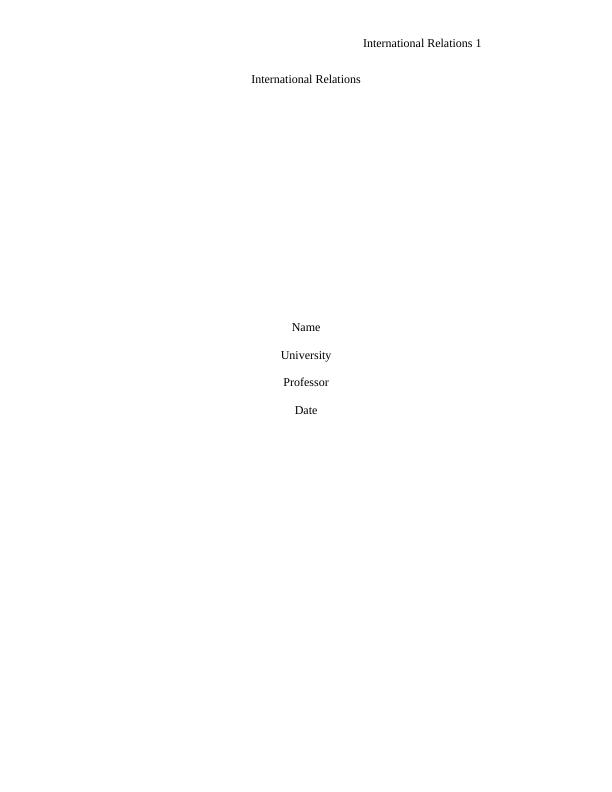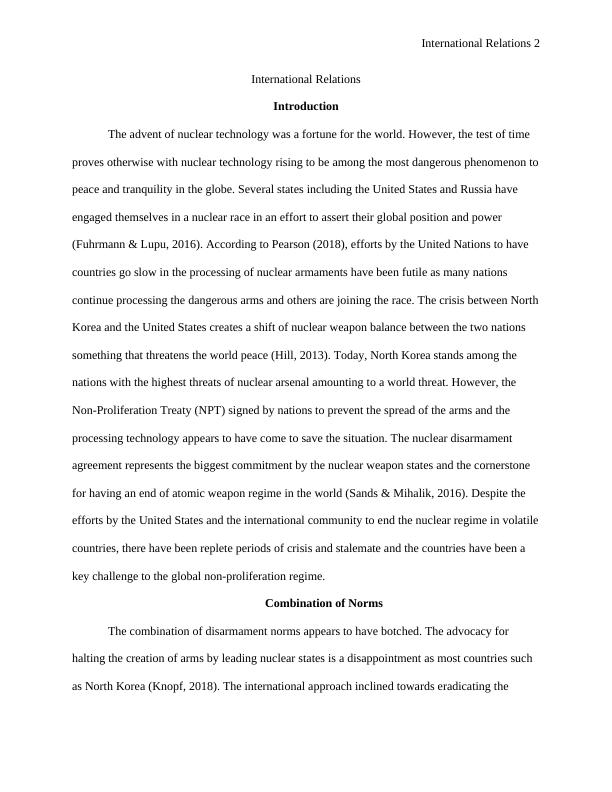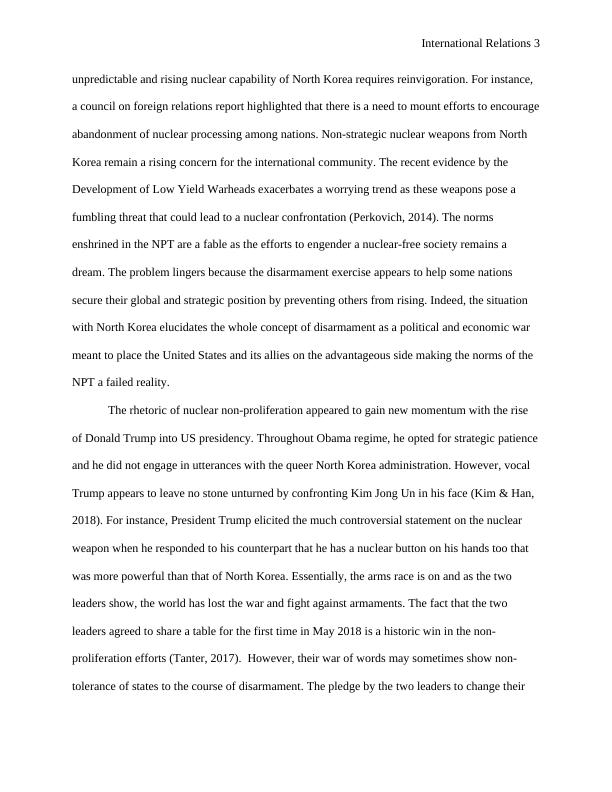International Relations and Nuclear Non-Proliferation
Added on 2023-06-03
10 Pages2934 Words273 Views
International Relations 1
International Relations
Name
University
Professor
Date
International Relations
Name
University
Professor
Date

International Relations 2
International Relations
Introduction
The advent of nuclear technology was a fortune for the world. However, the test of time
proves otherwise with nuclear technology rising to be among the most dangerous phenomenon to
peace and tranquility in the globe. Several states including the United States and Russia have
engaged themselves in a nuclear race in an effort to assert their global position and power
(Fuhrmann & Lupu, 2016). According to Pearson (2018), efforts by the United Nations to have
countries go slow in the processing of nuclear armaments have been futile as many nations
continue processing the dangerous arms and others are joining the race. The crisis between North
Korea and the United States creates a shift of nuclear weapon balance between the two nations
something that threatens the world peace (Hill, 2013). Today, North Korea stands among the
nations with the highest threats of nuclear arsenal amounting to a world threat. However, the
Non-Proliferation Treaty (NPT) signed by nations to prevent the spread of the arms and the
processing technology appears to have come to save the situation. The nuclear disarmament
agreement represents the biggest commitment by the nuclear weapon states and the cornerstone
for having an end of atomic weapon regime in the world (Sands & Mihalik, 2016). Despite the
efforts by the United States and the international community to end the nuclear regime in volatile
countries, there have been replete periods of crisis and stalemate and the countries have been a
key challenge to the global non-proliferation regime.
Combination of Norms
The combination of disarmament norms appears to have botched. The advocacy for
halting the creation of arms by leading nuclear states is a disappointment as most countries such
as North Korea (Knopf, 2018). The international approach inclined towards eradicating the
International Relations
Introduction
The advent of nuclear technology was a fortune for the world. However, the test of time
proves otherwise with nuclear technology rising to be among the most dangerous phenomenon to
peace and tranquility in the globe. Several states including the United States and Russia have
engaged themselves in a nuclear race in an effort to assert their global position and power
(Fuhrmann & Lupu, 2016). According to Pearson (2018), efforts by the United Nations to have
countries go slow in the processing of nuclear armaments have been futile as many nations
continue processing the dangerous arms and others are joining the race. The crisis between North
Korea and the United States creates a shift of nuclear weapon balance between the two nations
something that threatens the world peace (Hill, 2013). Today, North Korea stands among the
nations with the highest threats of nuclear arsenal amounting to a world threat. However, the
Non-Proliferation Treaty (NPT) signed by nations to prevent the spread of the arms and the
processing technology appears to have come to save the situation. The nuclear disarmament
agreement represents the biggest commitment by the nuclear weapon states and the cornerstone
for having an end of atomic weapon regime in the world (Sands & Mihalik, 2016). Despite the
efforts by the United States and the international community to end the nuclear regime in volatile
countries, there have been replete periods of crisis and stalemate and the countries have been a
key challenge to the global non-proliferation regime.
Combination of Norms
The combination of disarmament norms appears to have botched. The advocacy for
halting the creation of arms by leading nuclear states is a disappointment as most countries such
as North Korea (Knopf, 2018). The international approach inclined towards eradicating the

International Relations 3
unpredictable and rising nuclear capability of North Korea requires reinvigoration. For instance,
a council on foreign relations report highlighted that there is a need to mount efforts to encourage
abandonment of nuclear processing among nations. Non-strategic nuclear weapons from North
Korea remain a rising concern for the international community. The recent evidence by the
Development of Low Yield Warheads exacerbates a worrying trend as these weapons pose a
fumbling threat that could lead to a nuclear confrontation (Perkovich, 2014). The norms
enshrined in the NPT are a fable as the efforts to engender a nuclear-free society remains a
dream. The problem lingers because the disarmament exercise appears to help some nations
secure their global and strategic position by preventing others from rising. Indeed, the situation
with North Korea elucidates the whole concept of disarmament as a political and economic war
meant to place the United States and its allies on the advantageous side making the norms of the
NPT a failed reality.
The rhetoric of nuclear non-proliferation appeared to gain new momentum with the rise
of Donald Trump into US presidency. Throughout Obama regime, he opted for strategic patience
and he did not engage in utterances with the queer North Korea administration. However, vocal
Trump appears to leave no stone unturned by confronting Kim Jong Un in his face (Kim & Han,
2018). For instance, President Trump elicited the much controversial statement on the nuclear
weapon when he responded to his counterpart that he has a nuclear button on his hands too that
was more powerful than that of North Korea. Essentially, the arms race is on and as the two
leaders show, the world has lost the war and fight against armaments. The fact that the two
leaders agreed to share a table for the first time in May 2018 is a historic win in the non-
proliferation efforts (Tanter, 2017). However, their war of words may sometimes show non-
tolerance of states to the course of disarmament. The pledge by the two leaders to change their
unpredictable and rising nuclear capability of North Korea requires reinvigoration. For instance,
a council on foreign relations report highlighted that there is a need to mount efforts to encourage
abandonment of nuclear processing among nations. Non-strategic nuclear weapons from North
Korea remain a rising concern for the international community. The recent evidence by the
Development of Low Yield Warheads exacerbates a worrying trend as these weapons pose a
fumbling threat that could lead to a nuclear confrontation (Perkovich, 2014). The norms
enshrined in the NPT are a fable as the efforts to engender a nuclear-free society remains a
dream. The problem lingers because the disarmament exercise appears to help some nations
secure their global and strategic position by preventing others from rising. Indeed, the situation
with North Korea elucidates the whole concept of disarmament as a political and economic war
meant to place the United States and its allies on the advantageous side making the norms of the
NPT a failed reality.
The rhetoric of nuclear non-proliferation appeared to gain new momentum with the rise
of Donald Trump into US presidency. Throughout Obama regime, he opted for strategic patience
and he did not engage in utterances with the queer North Korea administration. However, vocal
Trump appears to leave no stone unturned by confronting Kim Jong Un in his face (Kim & Han,
2018). For instance, President Trump elicited the much controversial statement on the nuclear
weapon when he responded to his counterpart that he has a nuclear button on his hands too that
was more powerful than that of North Korea. Essentially, the arms race is on and as the two
leaders show, the world has lost the war and fight against armaments. The fact that the two
leaders agreed to share a table for the first time in May 2018 is a historic win in the non-
proliferation efforts (Tanter, 2017). However, their war of words may sometimes show non-
tolerance of states to the course of disarmament. The pledge by the two leaders to change their

End of preview
Want to access all the pages? Upload your documents or become a member.
Related Documents
PAIR1001 - Nuclear Disarmament Assignmentlg...
|9
|1921
|453
Campaign for Nuclear disarmament Assignment PDFlg...
|15
|4279
|103
Critical Assessment of both desirability and feasibility of nuclear disarmamentlg...
|6
|3004
|42
Nuclear Proliferation in Asian Countrieslg...
|13
|3473
|431
Challenges in Related to Proliferation of Nuclear Weaponslg...
|5
|1123
|495
Managing Negotiations for Denuclearization of the Korean Peninsulalg...
|11
|2949
|416
